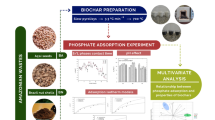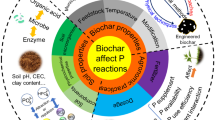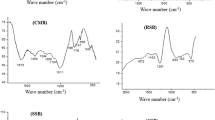Abstract
Background and aims
Biochars are highly variable in nutrient composition and availability, which are determined by types of feedstock and pyrolysis conditions. The aim of this research was to (a) study the bioavailability of phosphorus (P) in biochars using different feedstocks and pyrolysis conditions; (b) develop a robust chemical method for biochar P availability measurements.
Methods
In the present study, (a) chemical analysis – including total P and extractable P (2% citric acid, 2% formic acid, and neutral ammonium citrate extraction), and (b) a bioassay test using rye-grass grown in a P deficient sandy soil were used to compare the P bioavailability of different biochars. Biochars were produced from two different feedstocks (dairy manure-wood mixture, MAe; biosolid-wood mixture, BSe) at four different pyrolysis temperatures (250, 350, 450, and 550°C).
Results
Results showed that P in feedstock was fully recovered in the biochars. After 6 harvests, the biochars were as effective as the P fertilizers tested [Sechura phosphate rocks (SPR) and calcium dihydrogen phosphate (CaP)] in increasing the shoot yield. However, P uptake followed the order of CaP >MAe biochars >BSe biochars >SPR, on a same TP basis. Based on the Mitscherlich equation, 2% formic acid was the most sensitive indicator of P bioavailability in biochars.
Conclusions
The results suggest that high-ash biochars with high P concentrations are potential P sources with high-agronomic efficiency. We propose the use of 2% formic acid extraction to predict the availability of P in ash-rich biochars.






Similar content being viewed by others
References
Ahmedna M, Johns MM, Clarke SJ, Marshall WE, Rao RM (1997) Potential of agricultural by-product-based activated carbons for use in raw sugar decolourisation. J Sci Food Agric 75:117–124
AOAC (1999) 955.01 Calcium Carbonate Equivalence (CCE) - (Neutralizing Value of Liming Materials). In Official methods of analysis of AOAC International, Washington
AOAC (2005) Chapter 2, fertilizers. In Official methods of analysis of AOAC International, Washington
Azeez JO, Van Averbeke W (2010) Nitrogen mineralization potential of three animal manures applied on a sandy clay loam soil. Bioresour Technol 101:5645–5651
Bridle TR, Pritchard D (2004) Energy and nutrient recovery from sewage sludge via pyrolysis. Water Sci Technol 50:169–175
Bundy LG, Bremner JM (1972) A simple titrimetric method for determination of inorganic carbon in soils. Soil Sci Soc Am J 36:273–275
Calvelo Pereira R, Kaal J, Camps-Arbestain M, Pardo Lorenzo R, Aitkenhead W, Hedley M, Macías F, Hindmarsh J, Maciá-Agulló JA (2011) Contribution to characterisation of biochar to estimate the labile fraction of carbon. Org Geochem 42:1331–1342
Cantrell K, Ro K, Mahajan D, Anjom M, Hunt PG (2007) Role of thermochemical conversion in livestock waste-to-energy treatments: obstacles and opportunities. Ind Eng Chem 46:8918–8927
Chan KY, Xu Z (2009) Biochar: nutrient properties and their enhancement. In: Lehmann J, Joseph SM (eds) Biochar for environmental management: science and technology. Earthscan, London, pp 67–84
Chien SH, Sale PWG, Friesen DK (1990) A discussion of the methods for comparing the relative effectiveness of phosphate fertilizers varying in solubility. Nutr Cycl Agroecosys 24:149–157
Cordell D, Drangert J-O, White S (2009) The story of phosphorus: global food security and food for thought. Global Environ Change 19:292–305
De Luca TH, MacKenzie MD, Gundale MJ (2009) Biochar effects on soil nutrient transformations. In: Lehmann J, Joseph S (eds) Biochar for environmental management: science and technology. Earthscan, London, pp 251–270
Donahue CJ and Rais EA (2009) Proximate analysis of coal. J Chem Educ 86, 222-null
Free HF, McGill CR, Rowarth JS, Hedley MJ (2010) The effect of biochars on maize (Zea mays) germination. N Z J Agric Res 53:1–4
Gell K, van Groenigen J, Cayuela ML (2011) Residues of bioenergy production chains as soil amendments: immediate and temporal phytotoxicity. J Hazard Mater 186:2017–2025
Gregg PEH, Mackay AD, Currie LD, Syers JK (1988) Application strategies for Sechura phosphate rock use on permanent pasture. Nutr Cycl Agroecosys 17:219–234
Güngör K, Jürgensen A, Karthikeyan KG (2007) Determination of phosphorus speciation in dairy manure using XRD and XANES spectroscopy. J Environ Qual 36:1856–1863
Harmsen K (2000) A modified mitscherlich equation for rainfed crop production in semi-arid areas: 1. Theory. NJAS-Wagen J Life Sc 48:237–250
Harmsen K, Matar AE, Saxena MC, Silim SN (2001) Yield response to phosphorus fertilizer in a wheat-lentil rotation in a Mediterranean environment. NJAS-Wagen J Life Sc 49:385–403
Hedley M, McLaughlin M (2005) Reactions of phosphate fertilizers and by-products in soils. In: Sims JT, Sharpley AN (eds) Phosphorus: agriculture and the environment. American Society of Agronomy, Madison, pp 181–252
Hedley MJ, Tillman RW, Syers JK, Currie LD (1985) Evaluation of chemical criteria for assessing the amount of plant available phosphorus in superphosphate. Proceedings 20th Technical Conference of New Zealand Fertiliser Manufacturers’ Research Association. Volume I., 210–222
Hinsinger P (2001) Bioavailability of soil inorganic P in the rhizosphere as affected by root-induced chemical changes: a review. Plant Soil 237:173–195
Hossain MK, Strezov V, Nelson PF (2009) Thermal characterisation of the products of wastewater sludge pyrolysis. J Anal Appl Pyrolysis 85:442–446
Hossain MK, Strezov V, Chan KY, Ziolkowski A, Nelson PF (2011) Influence of pyrolysis temperature on production and nutrient properties of wastewater sludge biochar. J Environ Manag 92:223–228
Hunger S, Sims JT, Sparks DL (2008) Evidence for struvite in poultry litter: effect of storage and drying. J Environ Qual 37:1617–1625
Inguanzo M, DomInguez A, Menéndez JA, Blanco CG, Pis JJ (2002) On the pyrolysis of sewage sludge: the influence of pyrolysis conditions on solid, liquid and gas fractions. J Anal Appl Pyrolysis 63:209–222
Kercher AK, Nagle DC (2003) Microstructural evolution during charcoal carbonization by X-ray diffraction analysis. Carbon 41:15–27
Kleinman PJA, Sharpley AN, Moyer BG, Elwinger GF (2002) Effect of mineral and manure phosphorus sources on runoff phosphorus. J Environ Qual 31:2026–2033
Lehmann J, Joseph S (2009) Biochar for environmental management: an introduction. In: Lehmann J, Joseph S (eds) Biochar for environmental management: science and technology. Earthscan, London, pp 67–84
Lehmann J, Gaunt J, Rondon M (2006) Bio-char sequestration in terrestrial ecosystems – a review. Mitig Adapt Strateg Glob Chang 11:395–419
López-Martínez N, del Olmo A, Torrent J (2004) Dissolved reactive phosphorus in a Calcaric Fluvisol as affected by the addition of agricultural wastes. Soil Use Manag 20:74–80
Macías F, Camps Arbestain M (2010) Soil carbon sequestration in a changing global environment. Mitig Adapt Strateg Glob Chang 15:511–529
Mackay AD, Brown MW, Currie LD, Hedley MJ, Tillman RW, White RE (1990) Effect of shaking procedures on the neutral ammonium citrate soluble phosphate fraction in fertiliser materials. J Sci Food Agric 50:443–457
Mandile AJ, Hutton AC (1995) Quantitative X-ray diffraction analysis of mineral and organic phases in organic-rich rocks. Int J Coal Geol 28:51–69
McKenzie H, Wallace H (1954) The Kjeldahl determination of nitrogen: a critical study of digestion conditions-temperature, catalyst, and oxidizing agent. Aust J Chem 7:55–70
Middleton KR, Toxopeus MRJ (1973) Diagnosis and measurement of multiple soil deficiencies by a subtractive technique. Plant Soil 38:219–226
Palmer B, Bolland M, Gilkes R (1979) A re-evaluation of the effectivenes of calcined Christmas Island C-grade rock phosphate. Aust J Exp Agr 19:605–610
Plaza C, Sanz R, Clemente C, Fernández JM, González R, Polo A, Colmenarejo MF (2007) Greenhouse evaluation of struvite and sludges from municipal wastewater treatment works as phosphorus sources for plants. J Agric Food Chem 55:8206–8212
Rajan SSS, Brown MW, Boyes MK, Upsdell MP (1992) Extractable phosphorus to predict agronomic effectiveness of ground and unground phosphate rocks. Nutr Cycl Agroecosys 32:291–302
Singh B, Singh BP, Cowie AL (2010) Characterisation and evaluation of biochars for their application as a soil amendment. Aust J Soil Res 48:516–525
Smith KA, Chalmers AG, Chambers BJ, Christie P (1998) Organic manure phosphorus accumulation, mobility and management. Soil Use Manag 14:154–159
Soil Survey Staff (2006) Keys to soil taxonomy. USDA-Natural Resources Conservation Service, 10th ed, Washington, DC
Sparling GP, Barton L, Duncan L, McGill A, Speir TW, Schipper LA, Arnold G, Van Schaik A (2006) Nutrient leaching and changes in soil characteristics of four contrasting soils irrigated with secondary-treated municipal wastewater for 4 years. Aust J Soil Res 44:107–116
Wallis M, Horne D, Palmer A (1993) Water repellency in a New Zealand development sequence of yellow brown sands. Aust J Soil Res 31:641–654
New Zealand Water and Wastes Association (2003) Ministry for the environment New Zealand. Guidelines for the safe application of biosolids to land in New Zealand. http://www.waternz.org.nz/documents/publications/books_guides/biosolids_guidelines.pdf
Zimmerman AR, Gao B, Ahn M-Y (2011) Positive and negative carbon mineralization priming effects among a variety of biochar-amended soils. Soil Biol Biochem 43:1169–1179
Acknowledgement
The authors are deeply grateful to Mr James Hanly for providing the manure samples, Erwin Wisnubroto for providing soil samples, Associate Professor Bob Stewart for biochar XRD analysis, Mr Mike Bretherton, Mr Ian Furkert, Mr Bob Toes, and Ms Glenys Wallace for technical support. We also thank Prof. Felipe Macías from Universidad de Santiago de Compostela, Spain, and two anonymous reviewers for their review and constructive suggestions on this manuscript. The Palmerston North City Council supplied the biosolids, the Ministry of Agriculture and Forestry New Zealand funded this research, and Massey University funded Tao’s fellowship.
Author information
Authors and Affiliations
Corresponding author
Additional information
Responsible Editor: Johannes Lehmann.
Rights and permissions
About this article
Cite this article
Wang, T., Camps-Arbestain, M., Hedley, M. et al. Predicting phosphorus bioavailability from high-ash biochars. Plant Soil 357, 173–187 (2012). https://doi.org/10.1007/s11104-012-1131-9
Received:
Accepted:
Published:
Issue Date:
DOI: https://doi.org/10.1007/s11104-012-1131-9




